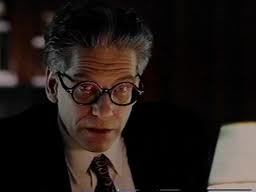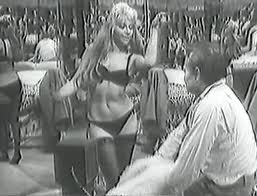Every time I hear someone crying "vampire fatigue" concerning the multitude of films that have been released in the past few years involving the creatures of the night, I laugh maniacally whilst moving
Stake Land,
Thirst and
Vampire Girl vs Frankenstein Girl ever further up my rental queue. However, even though I'm a super-fan of vampire movies, I understand the need to see, not only something of quality, but a film that is somehow unique to the genre and breaks the mold or reinvigorates it in some fashion. So instead of a movie that trots out the same old tired goth cliches of bats, castles and crucifixes, I picked three horror films to review that are set in quite unusual places with leads who are quite separate and distinct from the average vampire.
The Vampire's Ghost, Blood & Donuts and
Tremendo amanecer (Tremendous Sunset) all break traditional genre convention in one way or another and avoid dull predictability in the end. The three films are also wildly different from one another in plot, theme, style and tone. So when it comes to fighting vampire fatigue, just say 'Viva la difference, viva la vampire!'
Lesley Selander's 1945 black & white movie,
The Vampire's Ghost, is a modest, low-budget flick from Republic that features the African jungle as the unusual location in which its story is told. In lesser hands, the film could have been a campy disaster, but with a good, character driven script co-written by Leigh Brackett, solid cinematography by Robert Pittack and Bud Thackery and a strong lead performance by John Abbott, the film comes off as almost Lewton-esque.

Abbott, a long time studio contract player with over sixty films to his credit before switching to television, is probably best known for his role as Ayleborne, the spokesman for the Organians in the original
Star Trek episode
Errand of Mercy. His large expressive eyes, morose hang-dog face and indeterminate accent made him perfect for exotic, foreign heavy roles. In
The Vampire's Ghost, Abbott plays Webb Fallon, a local tavern owner in an African coastal town. His character of Fallon initially seems very cool and able to handle himself - much like Rick from Casablanca. At the outset, Fallon seems very much like a good guy. There's no hand-wringing or mustache twisting by his character to tip his hand, although he does put the hypno-whammy on a sore loser sailor by doing the 'big eyes' at him. When Fallon is introduced to newcomers, Roy (Charles Gordon) and Julie (Peggy Stewart) by the local clergyman, Father Gilchrist, he offers to help Roy who is looking into a series of murders that have taken place nearby. They become friends, but as strange things keep occurring, the local tribesman become suspicious of Fallon and he, in turn, starts to show interest of the non-platonic kind in Julie.

The first half of the film was quite interesting with seeming good-guy Fallon saving Roy's life, and Roy saving Fallon's. The latter half becomes more conventional and slows down a bit as Julie becomes the prize in a tug of war between the two men. Still, at 55 minutes, the film doesn't have much time to waste and gets to the point pretty briskly. The atmosphere was great despite being shot entirely on a sound stage. The native drums, which I usually find annoying in most jungle pictures, actually worked quite well here as they were kept low but constant and helped a lot in setting the mood. The acting was OK for the most part with Abbott really doing a fine job with his character in particular. Thankfully, unlike what's portrayed on the film poster, Abbott's character never sprouts fangs or does anything ridiculously vampy that would take the viewer out of the film. It's a good performance by an underrated actor, and along with the jungle setting, makes the film most enjoyable.
Score 7/10



If you ate a handful of 'shrooms and went to see a grown-up version of
Twilight, I imagine you'd experience something like Holly Dale's 1995 horror/comedy
Blood & Donuts. Gordon Currie stars as Boya, an awkward, shy vampire who has literally been in a bag somewhere in Toronto since 1969. When a golfer's errant tee shot awakens Boya, he stumbles out to a cab driven by an over-friendly, accent-impaired guy named Earl (Louis Ferreira) and they head for the cemetery where Boya has stashed all his possessions. Eventually, Boya comes across a local donut shop where he meets Molly the waitress, played by uber-browed Helene Clarkson and promptly falls for her. Of course complications arise as Boya's old flame shows up, cabbie Earl is pursued by thugs and their boss has to explain "The Bowling Shoe Rule" which delineates the difference between a mark and a smudge. The dialogue in the film is generally smile-inducing, especially David Cronenberg's crime boss, Stephen, who says at one point, "Am I employing retards? I have nothing against retards in general, I just can't afford to employ them." His deadpan delivery is perfect.

Fiona Reid as Boya's ex is also entertaining and a rather poignantly pathetic character as she has kept on aging during their 25 year separation and is more than a little resentful of the fact.
The pace of the film is somewhat slow, but this does allow time to admire the surprisingly sharp and colorful camera work from Atom Egoyan's regular cinematographer, Paul Sarossy. Holly Dale adds to the stylishness with some slow understated moves and the occasional dutch angle. The music is vampire-themed, but eclectic with artists like Concrete Blonde, who perform Bloodletting, to The Platters who do Twilight Time. Also, the original music by Nash the Slash is quite good.
Horror and comedy is a doubly tricky combination, but I thought Dale succeeded very nicely in pulling it off while keeping a steady, even tone throughout the duration of the film. The movie skates right up to the surreal and silly, but rarely crosses over to ridiculous. It's definitely not for everyone, especially the impatient, but it's a quality, one-of-a-kind work out of Canada.
Additional note: There's a throwaway scene at the end of the credits that's worth waiting around for.
Score 7.5/10

The DVD cover to Gustavo Postiglione's
Tremendo amanecer is more than a bit misleading as the film is very much a modern day story set in Buenos Aires. There aren't a lot of bats, bell towers or other gothic imagery to speak of in the movie. The one (possible) vampire is a club owner named Dante (Coki Debernardi). As the film opens, we see Dante soliciting a prostitute to cut her and drink her blood. Much like Romero's
Martin, it is unclear if this character is nuts or an actual vampire. I really like when this kind of ambiguity is employed in a vampire flick as it adds a whole other dimension to the film and character. Right after Dante's dealing with the prostitute, we meet Ramirez (Gustavo Guirado), a corrupt detective who is strong arming the streetwalkers for a cut of their earnings. When vampire-style murders begin occurring, Ramirez is pressured to break the case. Far from responding positively, Ramirez resents the pressure and mocks his boss. Both Dante and Ramirez are quite interesting characters and hold the film together. Dante's character is far from the vampiric norm as he likes to perform music at his club at night and watch videos of people frolicking in the daylight while at home. He often dreams of an old black and white film that features himself and a beautiful young woman. We eventually learn that this is Dante's long lost love who has vowed to return to him someday. One day, while watching the home videos, Dante sees a woman who is identical to the one in his dreams. He becomes determined to win her love again.

One of the more clever aspects to the story is that the bartender at Dante's club is an old friend of Ramirez. At several points in the story, Dante will be coming or going from the club while the barman talks to Ramirez, and even introduces the two to each other. A darkly comic element is subsequently introduced into the story with the appearance of Homero (Gabriel Goity), a church sponsored vampire hunter who is assigned to help Ramirez who is non-plussed, bemused and a little annoyed by his new partner.

Writer/director Gustavo Postiglione weaves these elements together seamlessly with an ending that is somewhat circuitous and completely satisfying. The story is the strongest element of the film followed closely by the tortured character of Dante who early on, and to his credit, seeks psychiatric help for the "curse" he believes he's been placed under. Like Boya in
Blood and Donuts, Dante doesn't really want to hurt anyone unless it's out of sense of self-preservation but is feeling an ever deepening depression. His days spent watching other people's home movies really adds to the pathos created. I loved the fact that the detective was a corrupt douche who really didn't care that much about catching the killer. It was so refreshing after seeing so many goody-good, Van Helsing types wear the white hat.
The big downside to the film, and it could be a deal-breaker to some, is the cheap shot on video look that the director tried to compensate for with even cheaper digital effects like blurring, adding color and moving the camera around needlessly. I rode the video storm out and was glad I did, but the film would have approached excellent territory without the gimmicks. Everything else was solid considering what was no doubt a tiny budget. The acting was decent and the music was surprisingly good and effective.
Score 7.5/10
If I had to recommend just one of these three films, I'd have to reluctantly go with Tremendo amanecer even though Blood and Donuts buries it in the visual esthetics department. The story is just so strong and the characters so unusual, I know I'll be revisiting Tremendo amanecer long before the other two films.




























